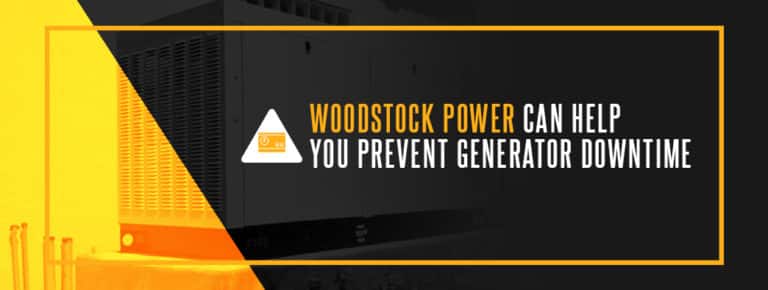Top 12 Reasons Commercial Generators Fail and How to Prevent Them
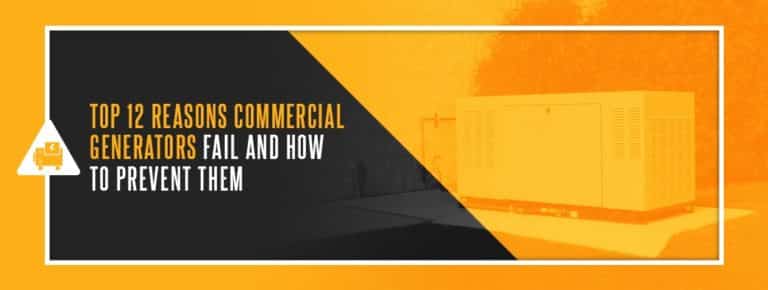
If you run a business or facility, installing a backup commercial generator to safeguard against power outages is a smart investment. Power loss can lead to detrimental results. If you’re a data center, the lack of ability to save data, data loss, and possibly even file corrupt can negatively impact your business and result in lost revenue. In manufacturing plants, processing plants, or order fulfillment services, power loss can result in production delays or halt delivery services entirely.
No matter the industry, a well-maintained backup generator can reliably power key systems and equipment to keep your daily operations running smoothly. But what happens if standby generators fail as well? It’s important to regularly service & maintain your generator to not only ensure that the generator is always ready to go when you need it, but can also point out potential warning signs that should be addressed.
If you keep up with regular generator service & maintenance, you can keep your commercial generator system functioning at its highest levels. While there are many reasons that a backup generator can fail, we’ve compiled a list of top reasons and ways to troubleshoot them. This guide reviews 12 possible failures that can occur with commercial standbys and the steps you can take to help prevent them.
- Lack of fuel or water contamination in diesel fuel
- Automatic operation not set
- Overheating
- Battery system failure
- Intake and exhaust valve debris
- Circuit breaker problems
- Tainted lubricants
- Short-circuiting Generator windings
- Operating at less than full load
- Low coolant levels and temperatures
- Switchgear complications
- Fuel, oil and coolant leaks
While we all wish backup generators were foolproof, you can take preventative measures to mitigate the negative impacts of power loss and keep your company on track, protecting your bottom line.
Why Do Commercial Generators Fail and How Can You Prevent These Failures?
Knowing why commercial generators fail is essential — but more importantly, you need to understand how you can solve the problem, and even better, prevent it from happening.
Commercial generators have high power outputs to support larger facilities in the case of a blackout. Sometimes it’s an overloaded power station, planned power outages to work on the local utility, damaged transmission lines, natural or man-made disasters, or even severe weather that causes an outage. Most commercial units are diesel or natural gas with large engines, durable metals, and components that are capable of outputting high wattage.
For you to gain a better understanding of diesel generator problems and solutions, take a look at the most common failures and how you can conduct preventative maintenance.
1. Lack of Fuel or Water Contamination in Diesel Fuel
If your standby generator is a diesel unit and seems to run out of fuel, it may be due to an inaccurate fuel level gauge. Compared to the movement found in a vehicle’s gas tank, a generator’s fuel supply is usually stagnant, and the unit uses a lower percentage of the fuel tank’s capacity. Gauges can also occasionally get stuck in a position until vibrations kick it free.
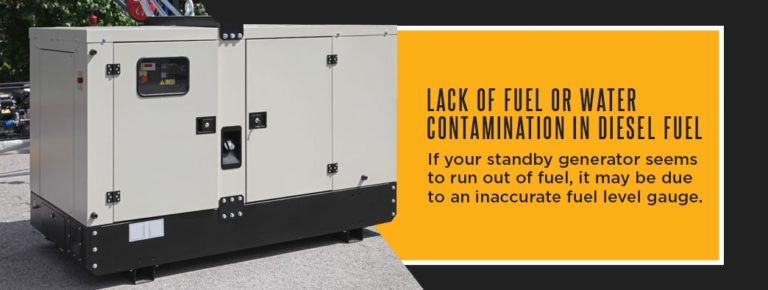
You should also take the time to add fuel to your tank when necessary. Low-level alarms trigger failure alarms when your fuel is sparse or can even prompt the generator to shutdown completely. Standby diesel generator systems have critical fuel level or low-level shutdowns to prevent the unit from sucking in air when it runs out of fuel.
If you run out of fuel because of plugged fuel filters, you can prevent it by maintaining the tank and checking for contaminants like dirt and water.
When it comes to the diesel fuel of any machine, water must not taint the fuel supply. Water or even small amounts of moisture in the fuel can damage a diesel engine, impacting the performance of the generator. Water creates advanced ignition, and specific properties of water also generate accelerated detonation. Fuel filter plugging can flush out the lines to get rid of the liquid.
You can also use fuel stabilizers to protect the diesel fuel from water. Sample the fuel regularly to check for discoloration and any abnormal smells. Diesel fuel can go bad over time and is known to pick up particulate matter and trace metals found in the storage tanks. While it’s not a cure-all, fuel stabilizers and treatments, including fuel polishing techniques can help combat these issues.
2. Automatic Operation Not Set
When dealing with a backup generator (also commonly known as a standby generator), these generators are usually paired together with an ATS (Automatic Transfer Switch) that prompts the generator to kick in when power from the main utility grid is cut off. This removes the need for manpower on-site and the generator should function autonomously with your custom preset configurations.
If your generator fails to run automatically, it’s an often result of human error. Generators that are set to run automatically can switch off when someone presses the emergency stop button or after you take the generator for servicing. Double-check that the master controls are set to run automatically before each use of the generator.
Some positions on the control switch will set the alarm off as well. For example, alarms and switchgears that are not reset means the generator isn’t in the put auto setting. If the main control switch or the reset position is off, if the breakers are open or if the emergency stop button is pressed, the alarm can trigger and result in a failure to start.
Several makes and models of standbys can short out or trip the circuit breaker when a fault shutdown happens. When the unit shuts down, you have to press the reset button to rid of clear the alarm. Does your generator have ground-fault sensors? It’s also essential to be familiar with your sensors and how to reset them if needed.
3. Overheating
The overheating of a generator can occur from cooling system failures that can be a result of worn or tattered hoses and drive belts. Make sure to inspect them regularly, checking to see if they work well and setting them at the ideal tension. You can also check the radiator core for dust and debris from dirty coolant and corrosion that can plug up the component. If you want to avoid system overheating, monitor the coolant. Make sure it’s clean with the correct chemical balance.
Another reason for an overheating generator could be due to insufficient aftermarket cooling solutions. While generator sets usually come with a cooling system and heat dissipation components, generator owners who elect to make aftermarket upgrades may install a cooling system that is not sufficient enough to keep the generator cool during peak operating conditions.
4. Battery System Failure
Battery failure is one of the top reasons commercial generators fail. You need to conduct routine maintenance to ensure peak performance of the battery. A key component in preventing battery errors is to clean and tighten its loose and dirty connections. You can investigate the circuit breaker on the charger too.
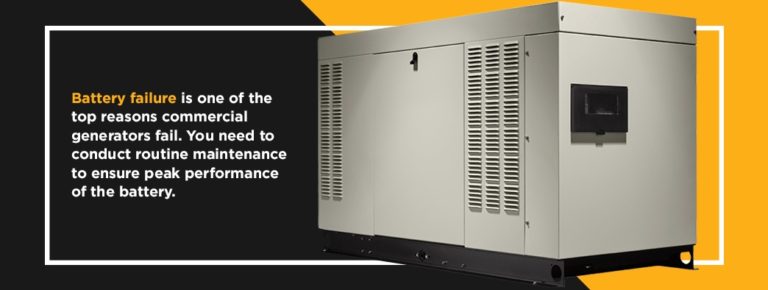
System failures also relate to a buildup of sulfation, which occurs when lead sulfates accumulate on the battery’s plates. The battery can’t deliver the correct amount of current when accumulation is present, and the battery needs replaced. Low electrolyte levels can also result in bad batteries.
Open cells are another reason batteries may need replacement, but this issue is not as common. Open cells result from an overcurrent of the system. A battery can fail because of a tripped or opened charger breaker due to human error.
Do you know the service life of the battery? It’s important to know so that you can replace it before it goes bad. At the end of its shelf life, a battery will provide only about 80% of its power.
5. Intake and Exhaust Valve Debris
Issues found within the intake and exhaust valves can affect the generator’s engine. Be sure to observe both valves during the start of operation as well as at regular intervals afterward. Valves that you don’t adjust correctly can become damaged. Debris in the parts can also impair key engine components, having the potential to cause massive repairs that may cost you more than expected.
6. Circuit Breaker Problems
As a regular maintenance check, you will want to make sure the circuit breaker trip settings match the load of the generator system. Adjust it according to each change of load you make. For example, when making a new installation, the current surges of the system can trip the circuit breakers that weren’t adjusted properly. If the circuit trips for a different reason, identify the problem before resetting. No matter what, keep up with regular circuit breaker maintenance.
7. Tainted Lubricants
Lubricating oil is a vital component in maintaining a running engine. It has a short lifespan, however. To keep your system healthy, change the lubricating oil, fuel filter and oil filter each year. Because backup generators often don’t run for more than several hours at a time, they are susceptible to moisture and acid contamination buildup on the engine.
8. Short-circuiting generator windings
Many, if not most, generator failures occur in the engine. But that doesn’t mean you should neglect generator windings. Damaged windings can result in system failures. The good news is that they are simple to prevent. Look for dust, oil or dirt on the windings because the gathering of any contaminant can retain condensation. The moisture buildup can cause the insulation to break down, and corrosion of the metal can occur.
Condensation will convert into steam when the generator starts up, which can form a short circuit. A grounded winding can also happen if insulation breaks down enough. Check for debris and test the insulation as needed.
9. Operating at Less Than Full Load
Generators that operate with little or no load can result in many problems. Commercial generators that often remain unused or seldom used must be exercised regularly in order to bring the generator up to maximum output and ensure the generator is capable of functioning properly.
In diesel generators, the term wet stacking describes how lubricating oil and unburned fuel gather in the exhaust stack. Carbon buildup happens in the combustion chamber along with other engine parts. Both are detrimental to how a generator operates, and they can cause unit failures. Wet stacking also prevents a diesel generator from running at maximum output, bringing down overall efficiency.
While natural gas generators do not experience wet stacking, like their diesel counterparts, natural gas generators must be exercised regularly to ensure operating capability.
Take preventative measures and conduct a yearly load bank test. A load bank test requires you to run the generator at full load — doing so can help prevent the negative effects of operating a machine on a lower load for the rest of its lifespan.
10. Low Coolant Levels and Temperatures
Internal or external leaks are the biggest reasons for a low coolant level. Keep a lookout for puddles when you inspect the unit — the color of the coolant can vary between red, orange, green and blue, depending on the manufacturer. Inspect the oil for changes, such as a milky appearance, as well.
Do the hoses on the standby unit have crust around them? This coating is another sign of leaking coolant. It can form when the liquid seeps, and the additives dry up. Radiator cores that are plugged in internally can also cause shutdowns due to low coolant levels. A generator under load will have thermostats that open, causing the radiator to prevent the right amount of coolant from moving through the core. Because the liquid has to go somewhere, it lifts over the overflow line. While the engine is cooling and the thermostats close, the liquid levels drop, triggering the low coolant shutdown.
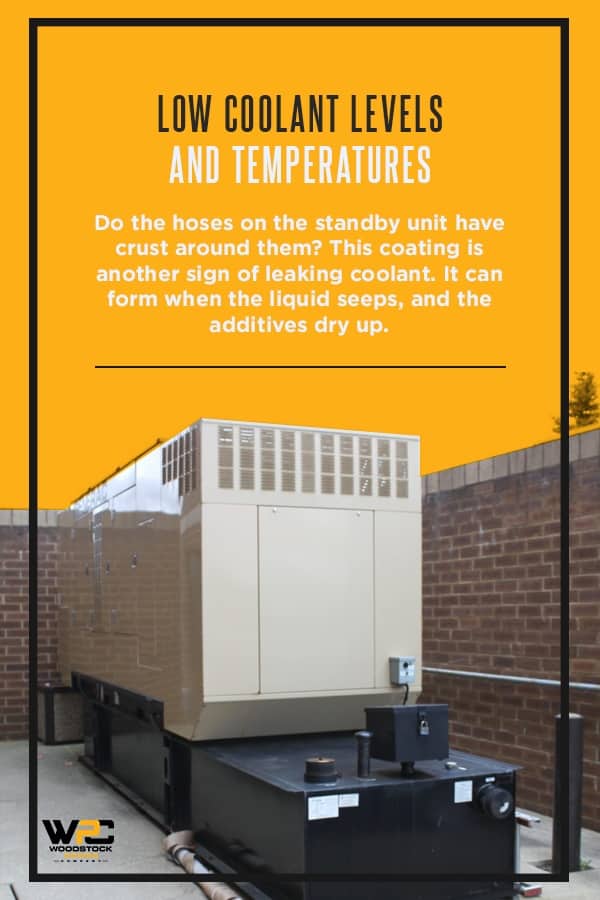
A shutdown can also occur when the switch-type sensors are implemented with the liners measured to the bottom and top of the radiator tanks. As the thermostat opens, the float switch lines have the least resistance. The flow creates a drop in the float, and the engine shuts down. You must test this with an external load bank to gain an accurate reading of the coolant system.
Low coolant temperatures can result from defective block heaters. Extreme temperatures in the blocks can cause the engine’s coolant to move through the generator system. High levels of heat from the heaters will form steam by flashing off the coolant, causing the liquid to evaporate. While the coolant may vaporize in small amounts, recording the coolant level and how much you add can help you find a trend.
If the block heaters get too hot, failure or damage to the engine can occur. The block heater settings should be between 100 and 120 degrees Fahrenheit.
11. Switchgear Complications
Switchgear is most commonly associated with an ATS (Automatic Transfer Switch) and are used in many applications, such as distributing power to designated circuits or used in conjunction with generator software to enable automatic generator paralleling. While simple applications mainly center around pairing together with the ATS in the event of power loss, generator switchgear is also known to work to designate power to emergency or hazard lights, critical ventilation systems, communications systems, security, safety, alarm, and monitoring systems.The moving parts need to be inspected because mechanical failures in a commercial generator can cause switchgear issues. The parts can seize if in a single position for an extended time.
12. Fuel, Oil and Coolant Leaks
Fuel leaks in your commercial generator can occur when you overfill the tank or if the pump system fails. Make sure to check the tank pump along with the emergency shutoff systems. Inspecting the fuel lines for cracks is also a part of maintenance.
Oil leaks are often a result of wet stacking or engine slobber — both terms relate to the excessive load time of a generator. If a unit operates below its rated output level, the engine can start wet stacking or over-fueling.
Wet stacking is when carbon particles, lube oil, unburned fuel, acids and condensed water accrue in the exhaust system. It’s caused when the combustion chamber has a low temperature. If the engine experiences wet stacking, you will need to clean it by loading the generator for several hours to burn off the excess fuel. If your unit runs with loads below the rated output level, use an auto load bank to deliver a false load on the system to prevent wet stacking.
Oil leaks can also occur from crankcase breathers that produce a puddle of oil that can coat the radiator and unit. The oil can then accumulate debris and dirt. You will want to install a recirculating breather to avoid the problem.
Finally, coolant leaks can happen in the hoses of block heaters. Use silicone hoses instead of rubber because the extreme temperatures can damage the rubber material. Maintenance for your cooling system will help dismiss leaks when you replace hoses and coolants about every four years or when either one fails. If you don’t maintain the coolant, it can cause severe impairment to the engine.
Our goal at Woodstock Power is to help you learn about your system’s settings and the procedures that go along with preventative and regular maintenance. Knowing how to deal with alarm systems and understanding how you can avoid generator washouts is fundamental in keeping your business running while others are in the dark.
Woodstock Power Can Help You Prevent Generator Downtime
When it comes to commercial generator troubleshooting, Woodstock Power can help you with potential issues. From battery testing and replacement to load bank testing and maintenance, our experts can keep your business running during any power outage with our expertise and tested machines.
We operate nationwide and offer rentals and long-term leases. Our products and services aid you in saving up to 70% off retail prices for generators. We can support you with turnkey solutions and installations and delivery of generators that can power your company whether you operate in the agricultural, education, healthcare or telecom industries.
To learn more about how our commercial generator solutions can safeguard your facility, or if you need further assistance with preventing generator failures, contact the Woodstock Power team online.


